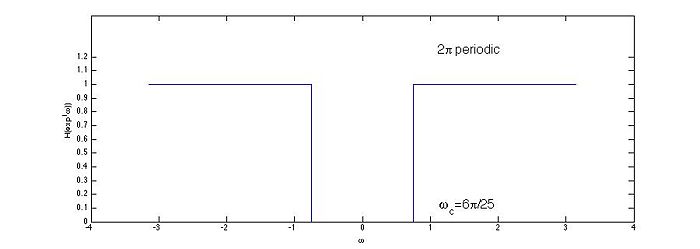| Line 32: | Line 32: | ||
<math>\omega_c=\frac{2\pi \cdot 1}{12}=\frac{\pi}{6}</math> | <math>\omega_c=\frac{2\pi \cdot 1}{12}=\frac{\pi}{6}</math> | ||
| + | |||
==Question 3== | ==Question 3== | ||
| Line 47: | Line 48: | ||
\end{align}</math> | \end{align}</math> | ||
| − | Replacing D with | + | Replacing D with 4 would be the answer. |
| Line 61: | Line 62: | ||
Since <math>X(w)</math> is periodic with <math>2\pi</math>, <math>Z(w)=X(Lw)</math> is periodic with <math>2\pi/L</math>. | Since <math>X(w)</math> is periodic with <math>2\pi</math>, <math>Z(w)=X(Lw)</math> is periodic with <math>2\pi/L</math>. | ||
| − | Replaing L with | + | Replaing L with 4 would be the answer. |
==Question 4== | ==Question 4== | ||
Revision as of 10:13, 8 October 2014
Contents
Homework 4, ECE438, Fall 2014, Prof. Boutin
Question 1
Conversion between analog and digital frequencies
To prevent aliasing, the sampling rate should be higher or equal to twice of the highest frequency of the signal.
$ \begin{align} f_s=2 \cdot 2500=5000Hz \end{align} $
So the sampling frequency should be greater than 5000Hz.
We need a high pass filter that filters out signals below the frequency 60Hz.
$ \begin{align} \omega_c=\frac{2\pi \cdot f_c }{f_s}=\frac{2\pi \cdot 60 }{5000} \end{align} $
Question 2
Conversion between analog and digital frequencies
We can think of the long term trend as low frequency component and annual cycle as high frequency component. In order to remove the annual cycle, we need a low pass filter. The sampling rate $ f_s=12 $samples/year. The periodic component has frequency of $ f_c=1 $cycle/year.
The cutoff frequency of of the ideal LPF is
$ \omega_c=\frac{2\pi \cdot 1}{12}=\frac{\pi}{6} $
Question 3
Downsampling and upsampling
$ \text{a)} \;\; \text{General Relation for the decimation with a factor of } D \,\! $.
$ \text{Let } X(w) = \mathcal{F}(x[n]) $
$ \begin{align} Y(w) &= \sum_{n=-\infty}^{\infty} y[n]e^{-jwn} = \sum_{n=-\infty}^{\infty} x[Dn]e^{-jwn} \\ &= \sum_{m=-\infty, m=Dk}^{\infty} x[m]e^{-j\frac{wm}{D}} = \sum_{m=-\infty}^{\infty} x[m] \left( \sum_{k=-\infty}^{\infty} \delta[m-Dk] \right) e^{-j\frac{wm}{D}} \\ &= \sum_{m=-\infty}^{\infty} x[m] \left( \frac{1}{D} \sum_{k=0}^{D-1} e^{j\frac{2\pi}{D}km} \right) e^{-j\frac{wm}{D}} = \sum_{k=0}^{D-1} \frac{1}{D} \sum_{m=-\infty}^{\infty} x[m]e^{j\left(w-\frac{2\pi}{D}k\right)m} \\ &= \sum_{k=0}^{D-1} \frac{1}{D} X\left(\frac{w-2\pi k}{D}\right) \\ \end{align} $
Replacing D with 4 would be the answer.
$ \text{b)} \;\; \text{General Relation for the upsampling with a factor of } L \,\! $.
$ \begin{align} Z(w) &= \sum_{n=-\infty}^{\infty} z[n]e^{-jwn} \\ &= \sum_{n=-\infty}^{\infty} \left( \sum_{k=-\infty}^{\infty} x[k] \delta[n-kL] \right) e^{-jwn} \\ &= \sum_{k=-\infty}^{\infty} x[k] \sum_{n=-\infty}^{\infty} \delta[n-kL] e^{-jwn} = \sum_{k=-\infty}^{\infty} x[k] e^{-jwkL} \\ &= \sum_{k=-\infty}^{\infty} x[k] e^{-jLwk} = X(Lw) \\ &\end{align} $
Since $ X(w) $ is periodic with $ 2\pi $, $ Z(w)=X(Lw) $ is periodic with $ 2\pi/L $.
Replaing L with 4 would be the answer.
Question 4
Downsampling and upsampling
a) For $ k=0,1,...,N-1 $
$ \begin{align} X_N(k) &= \sum_{k=0}^{N-1}x[n]e^{-\frac{j2\pi nk}{N}} \\ &= x[0]e^{-\frac{j2\pi 0\cdot k}{N}} \\ &= 1 \end{align} $
$ X_N(k) $ is periodic with N
- Instructor's comments: How about the other values of k? -pm
b) Using Euler Formula, we have
$ \begin{align} x[n] &= e^{\frac{j\pi n}{3}}(\frac{ e^{\frac{j\pi n}{6}} + e^{-\frac{j\pi n}{6}} }{2}) \\ &= \frac{1}{2}e^{\frac{j\pi n}{2}} + \frac{1}{2}e^{\frac{j\pi n}{6}} \end{align} $
Observing that $ x[n] $ has fundamental period $ N=12 $. Using IDFT, we have
$ \begin{align} x[n] &= \frac{1}{N}\sum_{n=0}^{N-1}e^{\frac{j2\pi nk}{N}} \\ \frac{1}{2}e^{\frac{j\pi n}{2}} + \frac{1}{2}e^{\frac{j\pi n}{6}} &= \frac{1}{12}\sum_{n=0}^{11}e^{\frac{j2\pi nk}{12}} \end{align} $
By comparison, we know for $ k=0,1,...,11 $
$ X_{12}[k] = \left\{ \begin{array}{ll} 6, & k=1,3 \\ 0, & otherwise. \end{array} \right. $
$ X_{12}[k] $ is periodic with 12.
- Instructor's comments: How about k=12, k=13, and all the other values of k? -pm
c)
$ x[n]=(\frac{1}{\sqrt 2} + j\frac{1}{\sqrt 2})^n = (e^{\frac{j\pi}{4}})^n $
Then $ x[n] $ has fundamental period $ N=8 $. Using IDFT, we have
$ \begin{align} x[n] &= \frac{1}{N}\sum_{n=0}^{N-1}e^{\frac{j2\pi nk}{N}} \\ e^{\frac{j\pi n}{4}} &= \frac{1}{8}\sum_{n=0}^{7}e^{\frac{j2\pi nk}{8}} \end{align} $
By comparison, we know for $ k=0,1,...,7 $
$ X_{8}[k] = \left\{ \begin{array}{ll} 8, & k=1 \\ 0, & otherwise. \end{array} \right. $
$ X_{8}[k] $ is periodic with 8.
- Instructor's comments: Don't forget to say that K[k} repeats periodically with period 8. THat way, all values of k are covered. -pm
Question 5
Observing that $ X(k) $ has a fundamental period $ N=4 $
$ \begin{align} x[n] &= \frac{1}{N}\sum_{k=0}^{N-1}(e^{j \pi k }+e^{-j \frac{\pi}{2} k})e^{\frac{j2\pi nk}{N}} \\ &= \frac{1}{4}\sum_{k=0}^{3}(e^{\frac{j2\pi (n+2)k}{4}} + e^{\frac{j2\pi (n-1)k}{4}}) \\ &= \frac{1}{4}\sum_{k=0}^{3}(e^{\frac{j2\pi (n+2)k}{4}-j2\pi k} + e^{\frac{j2\pi (n-1)k}{4}}) \\ &= \frac{1}{4}\sum_{k=0}^{3}(e^{\frac{j2\pi (n-2)k}{4}} + e^{\frac{j2\pi (n-1)k}{4}}) \\ \end{align} $
when $ n\neq 1 \text{ or } 2 $, using geometric series summation formula we have
$ x[n]=\frac{1}{4}( \frac{1-e^{j2\pi (n-2)}}{1-e^{\frac{j2\pi (n-2)}{4}}} + \frac{1-e^{j2\pi (n-1)}}{1-e^{\frac{j2\pi (n-1)}{4}}} ) = 0 $
when $ n=1 \text{ or } 2 $
$ x[n]=\sum_{k=0}^{3}1=4 $
$ x[n] $ will be periodic with 4.
NOTE: In general, $ X(k) $ does not need to have a length equal to the fundamental period. Suppose N is an arbitrary number, we can still derive the IDFT using argument that is similar to the one described above.


